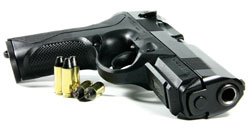A group led by Joe Wang at the University of California-San Diego, USA has developed a new forensic technique that can detect gunshot residue at the scene of the crime.
Gunshot residue consists of a large mix of compounds including both inorganic metals from the cartridge, bullet and the gun, and more complex organic compounds from the primer and gunpowder.
However, although gunshot residue contains this mix (including antimony, lead, barium, nitroglycerin and dinitrotoluene) it is currently detected by measuring the presence of just one component, such as antimony, which is unreliable at low concentrations as there are other sources of contamination.
In addition, tests currently involve taking a swab and then analysing it back in the lab. Being able to take the equipment out to the crime scene and perform tests without the need for specialised personnel is the eventual goal of the research, says Wang. ‘We want to identify, in the field, individuals who have fired a weapon,’ he explains.
Read the full article in Chemistry World
Link to journal article
Simultaneous Electrochemical Measurement of Metal and Organic Propellant Constituents of Gunshot Residues
Joseph Wang
Analyst, 2012, Accepted Manuscript
DOI: 10.1039/C2AN35379B, Paper











